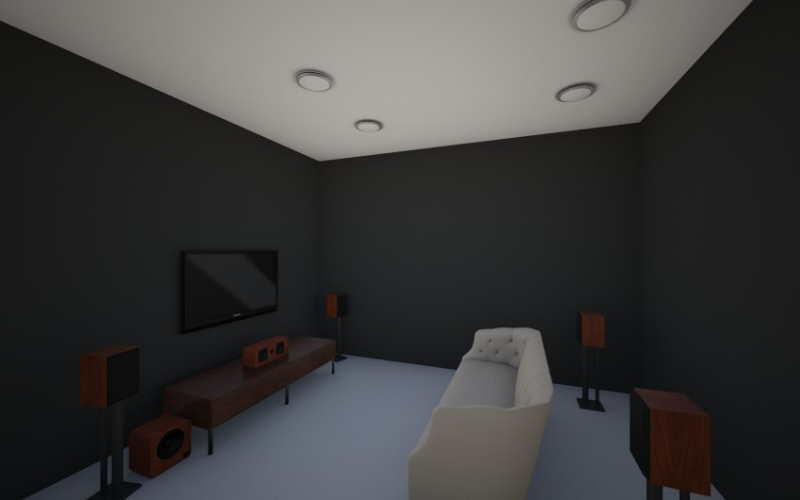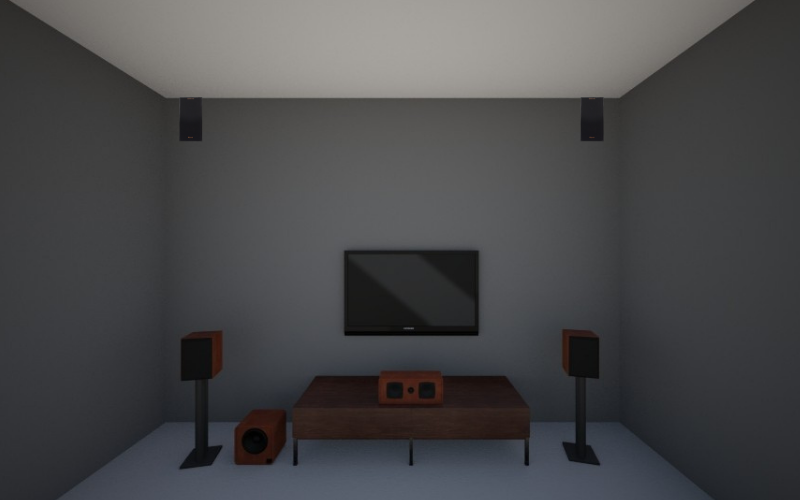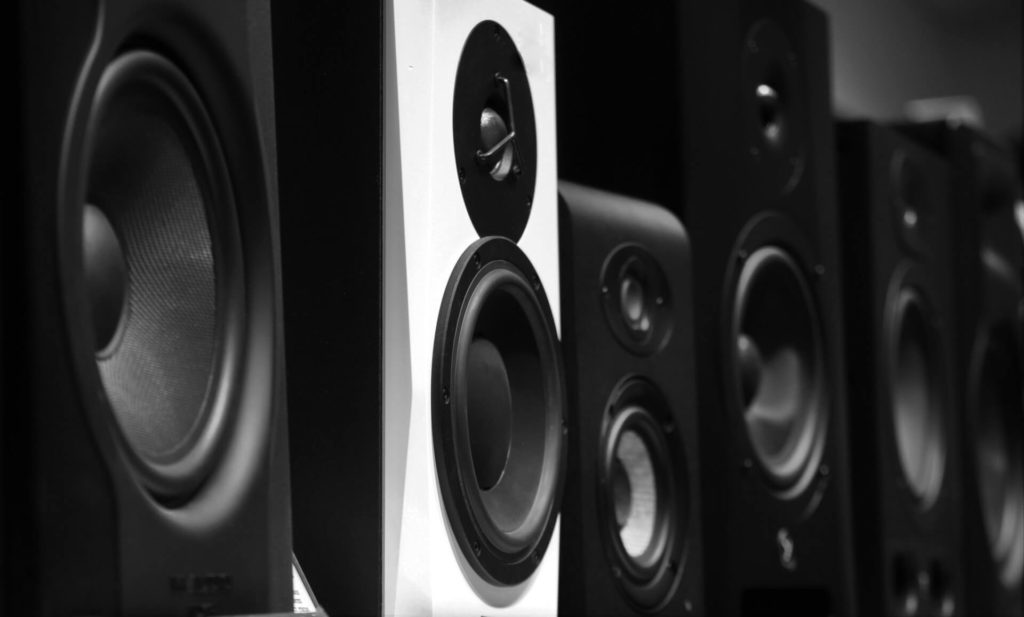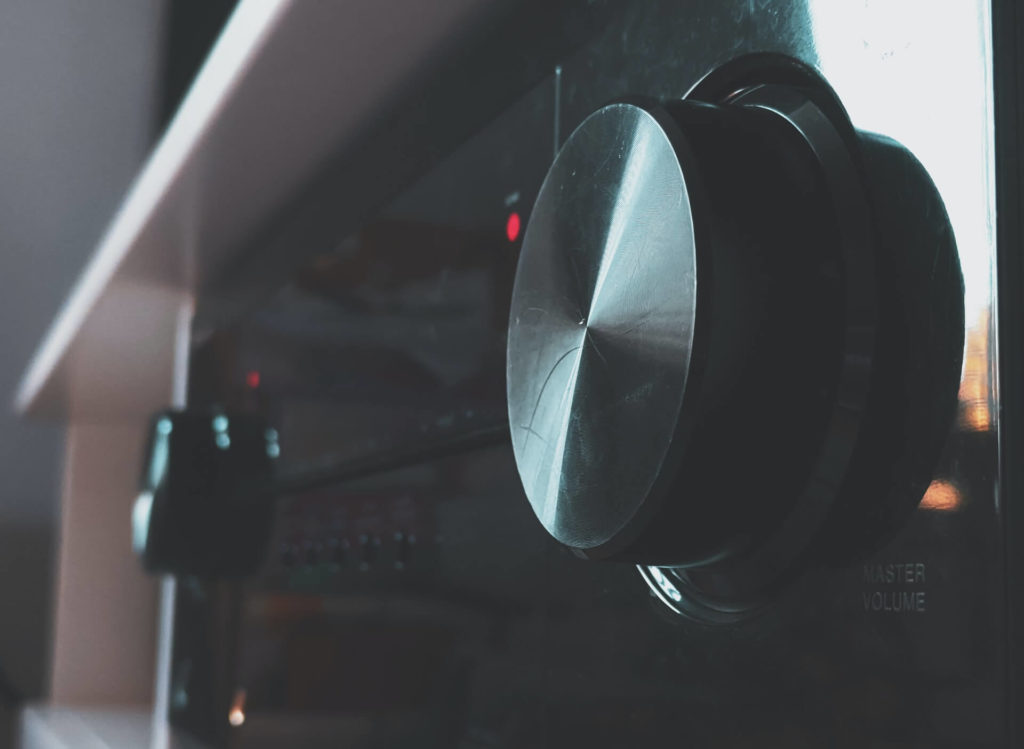We’re often asked if Dolby Atmos without ceiling speakers is possible. The short answer is yes. We all want a theater-like movie-watching experience at home. Dolby Atmos is a big step toward that. Unfortunately, sometimes that means extra money. You do have options when it comes to speakers for Atmos overhead effects. That includes achieving Dolby Atmos without height speakers or ceiling speakers. We’ll break down those options in a simple way. You do not need ceiling speakers for a Dolby Atmos setup.
Dolby is one of the industry’s leading businesses, having been at the forefront of technological breakthroughs in home theater sound systems. In this article, we’re focusing on their Dolby Atmos technology. We’ll go over what Dolby Atmos sound is. We’ll also go touch on what speakers you’ll need and how it differs from other technology.
Can You Use Dolby Atmos Without Ceiling Speakers?

Yes, Dolby Atmos is possible without ceiling speakers. Although Atmos ceiling speakers provide the best Dolby Atmos surround sound experience, some people may be unable to accommodate them. You will of course first need a Dolby Atmos-enabled AV Receiver and Atmos-encoded content. What type of speaker can be used?
When it comes to simulating realistic overhead sounds, Upfiring and front height Atmos speakers can be used in addition to ceiling speakers. To utilize Dolby Atmos audio in your home theater you can use one of three speakers. These speakers, depending on their number, can be arranged in a variety of ways to enhance the Atmos experience.
The alternative speakers we’re suggesting shouldn’t be confused with Dolby Atmos Height Virtualization. Height virtualization via Dolby Atmos can be achieved with some AV receivers. Height virtualization aims to mimic or recreate the Dolby Atmos experience of overhead effects. Dolby Atmos Height Virtualization attempts to do this with listener-level speakers or even a soundbar. This differs from using Atmos ceiling speakers, height speakers, or upfiring speakers that actually place these overhead Atmos effects above the listener. We break down the pros and cons of each option below.
Best Types of Speakers For Dolby Atmos Audio

Ceiling speakers
Atmos ceiling speakers are specially designed to be installed in ceilings. They are the best type of speaker for a Dolby Atmos system. These overhead speakers are strategically placed in ceilings to provide the most immersive sound experience possible. Using Atmos ceiling speakers requires no special certification. Any ceiling speakers that can connect to your AV receiver will work.
It is possible to produce an Atmos experience in a small room by using a pair of ceiling speakers placed above the seated location. A larger room, on the other hand, may require four speakers. Much of this will depend on speaker placement and the location of the listener. Atmos ceiling speakers are the type of speaker you want for the best Dolby Atmos sound.
Pros
- Provide the most realistic overhead effects
- They don’t take up any shelf or floor space
- Perfect for a new build or a refurbishment
Cons
- Difficult installation/May require professional help
- More expensive
Height Speakers
Height speakers, also known as direct radiating height speakers, are mounted on the wall near the ceiling. Height speakers are typically utilized in two or four-speaker configurations. A setup with two height speakers typically means two front height speakers. A four-speaker setup would add 2 rear height speakers. Height speakers can similarly be installed on the side of the listener too. Height speakers perform extremely well as Dolby Atmos speakers. They provide an enveloping and immersive experience along with flexible placement.
Pros
- Produces a more diffusable sound
- Easier to install than ceiling speakers
- Flexible placement options
Cons
- Drilling holes might be necessary
- Installation may be difficult
Upfiring speakers
Yes. Dolby Atmos without height speakers is possible too. Front upfiring speakers are sometimes called ceiling reflected speakers or upward-firing speakers. Atmos upfiring speakers are upward-facing speakers that project sound to the ceiling. This sound is reflected off the ceiling down toward the ears of the listeners. They are often placed on top of floorstanding speakers or bookshelf speakers. They are even built into some floorstanding speakers, including the popular Klipsch R-26FA. Some soundbars also incorporate upfiring components.
Pros
- Sound effects are reflected off the ceiling and into your ears by using angled drivers
- Can be placed on top of floor-standing or bookshelf speakers
Cons
- A ceiling height of 8-9 feet is required
- The reflective composition of ceilings should be consistent to get the desired effects.
- Least realistic overhead effects
What is Dolby Atmos?

When you watch movies at home, it is not always about the picture quality. Audio quality is just as significant as picture quality. Several significant changes have been made to the way sound is delivered in home theaters. Watching movies at home has become more enjoyable and immersive as a result.
According to Dolby, “Atmos” is the most significant advancement in cinema audio since surround sound. Atmos uses object-based audio to allow content creators to position and move sounds, effects, and music in three-dimensional space — all of which may be reproduced with Atmos ceiling speakers, height speakers, and upfiring speakers. This elevates your viewing, gaming, and listening experiences to new aural heights.
Dolby Atmos Height Virtualization is a feature for listening-level speakers. It uses a special digital signal processing technique to mimic the overhead effects from Dolby Atmos soundtracks. Dolby Atmos Height Virtualization is essentially trying to trick the user. While it can be a value-added feature, it doesn’t compare to the full Dolby Atmos audio experience.
Does Dolby Atmos Make A Difference?
Yes, listening to a Dolby Atmos soundtrack with properly positioned speakers can be an exciting experience. The audio is significantly more immersive. At appropriate times, there is a wonderful combination of height and on-screen action. Overhead effects such as rain, thunder, fizzing bullets, and planes shine most for Dolby Atmos surround sound. The sounds of caves and tunnels are bizarre. Unfortunately, not a ton of Dolby Atmos content is available at the moment. Luckily, it’s constantly increasing thanks to new content. There has also been a recent surge of Dolby Atmos music made available.
Dolby Atmos vs DTS: X
DTS:X is an object-based audio technology, similar to Dolby Atmos sound. In contrast to Dolby Atmos, DTS:X has no requirements for additional height channels, nor does it have any restrictions for a specified number of speakers in any arrangement. You do not need to use a height or overhead speaker when using DTS: X. An auto-calibration feature and an object-based processor on your DTS: X-enabled receiver will take care of the hard work. It will then deliver multi-dimensional sound through the output channel it determines is the optimum fit.
Users can also change the level of voices using DTS: X. This is a useful function for scenes with a lot of conversation, which can be difficult to hear well in many movies. Dolby Atmos content is significantly more widely available than DTS: X. Dolby Atmos material can be found in movies, video games, music, and streaming sites/apps. DTS: X content appears to be limited to mostly Blu-ray discs.
Conclusion: Dolby Atmos Speakers

Hopefully, we cleared up some of the confusion related to Dolby Atmos and ceiling speakers. While ceiling speakers are your best bet for a top-notch experience, front-height speakers work great also. Atmos ceiling speakers can also be a lot of hassle and we all love convenience. Height speakers are the next best choice.
But Dolby Atmos without height speakers or ceiling speakers is still possible. Some people opt for Upfiring speakers, which may also work for your listening space. While not optimal for the best Dolby Atmos sound, they are by far the easiest to set up. You will have to make the best choice for your use case and budget. Remember you can always upgrade. Happy movie-watching!
FAQs: Dolby Atmos Speakers
What are Dolby Atmos Enabled Speakers?
Dolby Atmos enabled speakers are somewhat a product marketing and the confusion around Atmos speakers. Speakers don’t require this label or certification to be used for Dolby Atmos audio. Upfiring speakers are most likely to be labeled as Dolby Atmos enabled speakers. Ironically, they are often thought to provide a sup-optimal Dolby Atmos experience. You will find the label on some other types of speakers. Don’t think that this label is required for Dolby Atmos support though.
Where Can Dolby Atmos Music?
The Surround Sound Atmos experience is also available for music. Unfortunately, Dolby Atmos music isn’t as readily available. The best place to stream is Tidal Hi-Fi. You can also listen to Dolby Atmos music via the Amazon Echo Studio. You will need Amazon Music Unlimited for that feature.
Do I Need An A/V Receiver For Dolby Atmos?
Yes. You’ll need a Dolby Atmos-enabled receiver to set up a Dolby Atmos system. The AV receiver will be needed to process the Dolby Atmos metadata properly. If you attempt to stream Dolby Atmos content without this, you may still get surround sound. It will just be an older technology like Dolby Digital Surround.
What Do I Need For A Dolby Atmos Setup?
You’ll need 3 things for a proper Dolby Atmos surround sound experience. An AV Receiver that supports Atmos is needed to properly decode Atmos metadata. You will also need the right speakers to achieve the Atmos Experience. That includes (at a minimum) a 5.1 speaker setup plus at least two additional speakers for overhead Atmos effects.
Your options for those are upfiring speakers, height speakers, or ceiling speakers. Lastly, you’ll need the proper source content. This can actually be two-fold depending on your set-up. If you’re streaming, you’ll need a device (like the Nvidia Shield TV) that support Dolby Atmos. Then you’ll have to find Dolby Atmos content on a supported streaming service. Achieving a Dolby Atmos setup will be less complicated as more services and devices receive Dolby Atmos capability. These Dolby Atmos updates are constantly happening. Sometimes they can be done via software updates.
How Many Speakers Do I Need For Dolby Atmos?
The minimum for a proper Dolby Atmo setup is a 5.1.2 configuration. That includes two front speakers, a center channel, two rear surrounds, a subwoofer, and two more speakers specifically for Dolby Atmos effects.

Keith Collins has been writing for over 15 years for various publications. He’s a lover of music, home theater, and excellent sound quality. His fondness for technology in addition to his non-stop curiosity fuels his writing ventures.